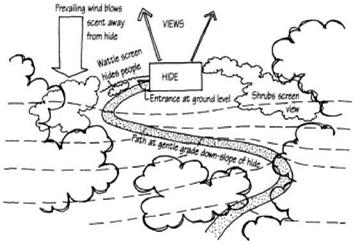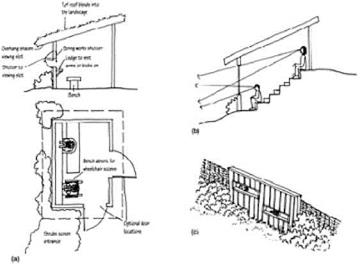One of the best ways to identify and observe wildlife is from a hide where the approach is camouflaged
and from which a good, clear view can be obtained. Benches to sit on, an aperture to look through, and the knowledge that the animals or birds are undisturbed by the human presence—all add to the enjoyment.
Many organizations have developed facilities to enable visitors to observe wildlife in this way. Occasionally the observation is also used to protect rare species, especially birds, during the nesting season. Thus visitors appreciate the sight of birds feeding their young and understand something of the need to protect them from egg thieves or unscrupulous hunters.
As with any facility, places for wildlife observation will need some design consideration and input. If the site is particularly attractive, large numbers of visitors might arrive to see breeding, migrating or overwintering birds or animals. Hence there might be a need for large-capacity hides, good paths, proper car parking and toilet facilities. All of these, except the hide, have been dealt with already. The design of the hide or observation point is the next thing to consider.
The approach to the observation point should be designed so that the visitor is downwind and out of sight. Landform can be used to ensure that the trail is below a ridge or behind a slope. Thick vegetation can also be used to screen the access, and is ideal in most cases. Screen fencing, preferably as a temporary measure, can be used to fill any gaps or to cover the last stretch before the hide itself. Woven hazel fencing or any visually opaque material taller than head height is satisfactory. If people with disabilities are to look at the wildlife, the approach path will have to take account of the gradient and the surface needed by them as well as the hidden approach.
In a simple form the hide can consist of a section of fence with viewing slots or holes through which people can look. The slots can be at different levels to permit use by smaller people, children or wheelchair users. If the hide can be orientated so that the sun is usually behind it, the wildlife will be front lit and easier to see and better to photograph. Lenses of binoculars or cameras will not catch the light and
 |
A layout of a – wildlife observation hide area, showing the factors that should be accounted for in the design.
 |
Some considerations in wildlife
observation hide design: (a) The layout of a simple hide with access for wheelchairs. (b) A larger-capacity hide with tiered seats to
accommodate bigger groups of people such as a school party or bus trip. (c) A simple hide made from a timber screen wall with viewing slots is cheap but effective.
alarm the wildlife, and the shady, back-lit face of the hide will be less obvious.
In order to be used all year and in all weathers an enclosed building should be constructed. A neutral, simple form that merges into the background will cause least intrusion. Often a wooden structure will suffice, either square, rectangular or polygonal in shape with a monopitch roof, perhaps covered in turf, thatch or branches, accessed from the rear either at ground level or from a gently graded ramp. Its capacity and sophistication should reflect the degree of use expected. If coachloads of ornithologists or school-children are regular visitors then a large building may be needed containing raked seating and a large window through which to see the wildlife. A big window means that the interior of the hide should be kept dark to avoid the sight of moving people. A screen or shutter can cover the window while people go in and out with a light on and then be opened to reveal the wildlife. An overhanging roof will ensure that shadow is cast over the window to keep it darker still. For winter observation in cold climates, double glazing, insulation and heating may also be required. Benches and ledges to rest binoculars or cameras on will assist people staying to see more elusive wildlife. Posters showing the characteristics of the different wildlife can be put on the walls.
Aquatic wildlife such as fish can be viewed in several ways—from below or from above. There are examples of submerged structures equipped with windows of strong, thick glass through which views into the river or lake can be obtained. These are expensive to construct but they give an unusual and exciting view of fish from within their habitat. A boat with a clear plastic or toughened glass panel in the bottom of the hull is another method.
 |
Viewing platforms can also be constructed that jut out over a river or lake. In places where migratory fish come up to spawn the sight of thousands of salmon or sea trout can be awesome, especially as they try to jump up rapids, and such platforms give more people a better view. The kind described in Chapter 9 can be used for this purpose.


